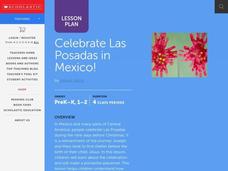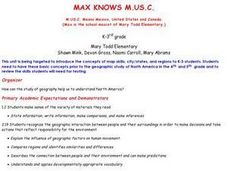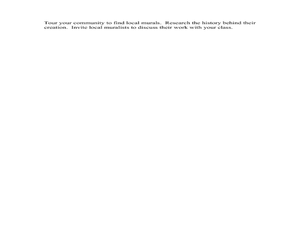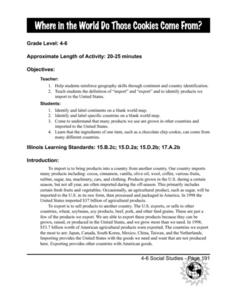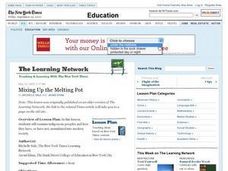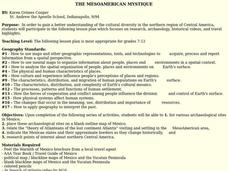Curated OER
Let's Travel to Mexico!
Students investigate and explore information about Mexico. They listen to a story, view an Internet video, write a page for a class book, and play an online Spanish word concentration game.
Curated OER
Mexico
Students complete a unit about the geography and culture of Mexico. They compare and contrast the weather of their own city and Mexico, read books about Mexico, count in Spanish, color in a flag of Mexico and the Mexican Coat of Arms,...
Curated OER
Geography and Artifacts of Mexico
Students review the structure of government in Mexico and discuss how it is different than the United States. Using artifacts, they must label and identify the city or state in which the artifact originated. They use the artifact clues...
Curated OER
Everybody Celebrates
Examine the holidays of La Posada in Mexico, Hanukkah in Israel, and Kwanzaa in the United States. Learners identify the countries on a world map, listen to stories, create art projects for each holiday, and make recipes celebrating the...
Curated OER
Dia de los Muertos
Second graders research the Day of the Dead, an important Mexican holiday. They view videos, investigate Mexican geography and history and compare the Day of the Dead to the celebration of Halloween.
Curated OER
Celebrate La Posada in Mexico!
Students locate and identify Mexico on a world map. They develop an understanding of celebrating La Posada in Mexico as they listen to a story about the tradition of La Posada. They create a representation of a pointsettia. They act out...
Curated OER
Chiapas, Where Is It and Why Should We Care? And What Is the EZLN?
Young scholars research and discuss the Zapatista National Liberation Army of Chiapas, Mexico. They role play the involved parties in the conflict and attempt to debate a peaceful solution.
Curated OER
Max Knows Mexicao, United States and Canada
Learners utilize their map skills to explore the regions of North America. They explore the physical characteristics and climates of the regions. Students label their map and prepare a presentation of their findings.
Curated OER
Why is there Pollution in Mexico City?
Learners explore the causes of air pollution in Mexico City from a holistic approach.
Curated OER
Murals: Historic Walls
Young scholars examine Mexican history in murals. In this visual arts lesson, students research the artistic style of Mexican murals and the artists that create them. Young scholars then present their research findings to their...
Curated OER
East to West: Africa's Influence on Mexico
Your historians and social anthropologists study the relationship between peoples of ancient Africa and ancient Mesoamerica. They relate in written or verbal form the African presence in the ancient Americas. They create their own...
Curated OER
Celebrate Hanukkah in Israel
Explore Hanukkah and its origins with a social studies lesson. Learners discover the history of Hanukkah and its traditions. They locate Israel on a map, hear the story of the menorah and create their own dreidel. Afterwards, they sing...
Curated OER
Ofelia Romero The Maya Culture and Civilization
Fifth graders investigate the Mayan culture, number system, alphabet, hieroglyphics, history, civilization, artistry, and sports in this series of lessons.
Curated OER
The Heart of Human Experience: Cultura Azteca
First graders explore Aztec culture to gain understanding of relationship between music, recreation, and culture. Seven lessons on one page.
Curated OER
Where in the World Do Those Cookies Come From?
Students discuss exports and imports by discovering where the ingredients come from for making chocolate chip cookies. They take a survey of their favorite cookies and create a bar graph to represent the information.
Curated OER
You're In My Space!
Students explain how political, social, and economic boundaries can be changed through cooperation and conflict. Small groups are assigned a particular trouble area of the world. Each group studies a particular side of the conflict.
Curated OER
The Mesoamerican Mystique
Students gain a better understanding of the cultural diversity in the northern region of Central America. They engage in a lesson which focuses on research, archaeology, historical videos, and travel highlights.
Curated OER
Hafta Do NAFTA?
Students examine the benefits and problems of U.S. participation in the North American Free Trade Agreement. In two groups, students represent the campaign team for a presidential candidate, one for and one against NAFTA, and research...
Curated OER
The Dust Bowl and the Ogallala Aquifer
Students research the characteristics of the Great Plains as an agricultural area. They examine farming techniques from the past and how those farming techniques are used today. They investigate the present uses of the Ogallala Aquifer.
Curated OER
Mixing Up the Melting Pot
Students examine the cultures of indigenous peoples and how they have or have not assimilated into modern society. They create reports with recommendations on how the Nukak of Columbia could be assimilated into society.
Curated OER
Foods and Languages of the World
Students create their own ice cream sundae given various toppings from around the world. In this foods and languages of the world diversity lesson, students develop an understanding of diversity in culture, family structure, ability and...
Curated OER
THE MESOAMERICAN MYSTIQUE
Learners research, archeology, historical videos, and travel highlights in the northern region of Central America. They identify the various archaeological / historical sites along with a date of probable existence and the title of the...
Curated OER
The Rooster Who Went to His Uncle's Wedding
Second graders read and discuss the story "The Rooster Who Went to His Uncle's Wedding" in the Scott Foresman series. They summarize the story. They understand the influence of Latin American Folktales. They complete a quiz on the story.
Curated OER
Arsenic Contamination: Water Filtration
Students work in groups to design a filtration process that will separate clean water from polluted water. They organize data in tables or graphs and present their findings to the class. Students identify further safety protocols that...







